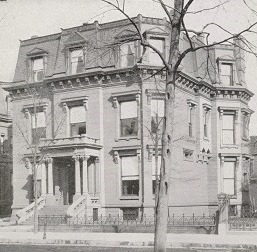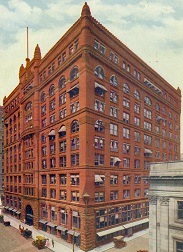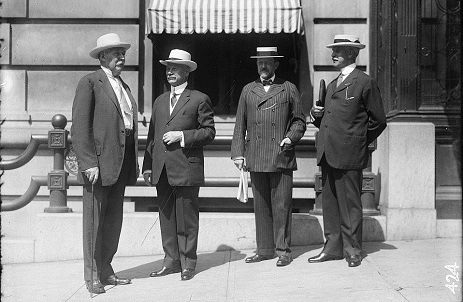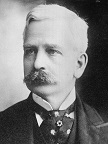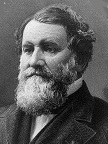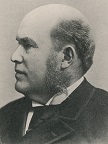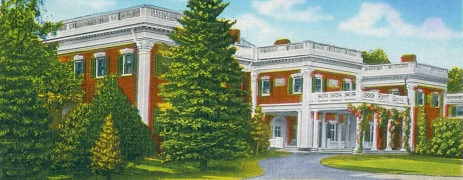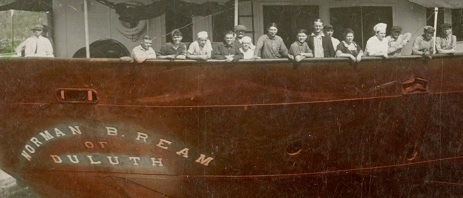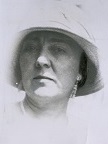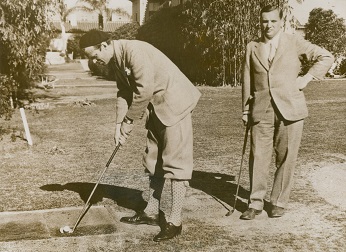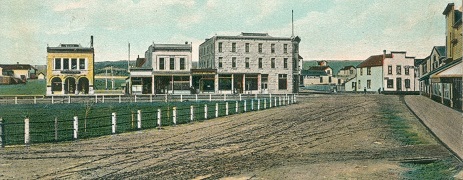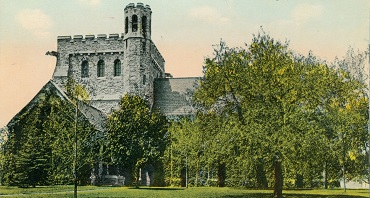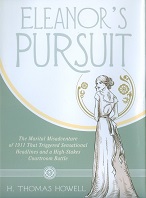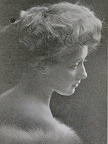
|
Norman Bruce Ream |
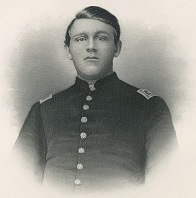 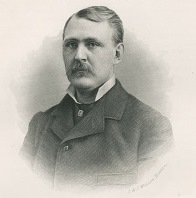 |
Norman B.
Ream, in Civil War years and later as a businessman |
Norman Bruce Ream was born on Nov. 15, 1844 in a small log cabin in Ursina, Somerset County, PA, the son of Levi and Hila (King) Ream.
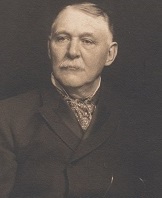
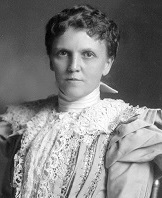
Thompson Historical Society
Having grown into adolescence as a farmer, at the age of 14, Norman took a class at a local "Normal Institute," devoted to educating teachers, and then pursued teaching. As a young man, he stood 6 feet, 2 inches tall. Just before the Civil War, he apparently became a store clerk in Harnedsville, near Somerset, and began a fledgling ambrotype photography business.
After the outbreak of the Civil War, Norman went to his parents and advised them of his intent to enlist. "They were as patriotic as he," said Alfred Theodore Andreas in his book History of Chicago, and "gave their consent and blessing." With their support secured, Norman and his cousin Ross R. Sanner enlisted at nearby Somerfield, Somerset County, and then walked a 29-mile distance from Ursina to Uniontown, PA to be formally mustered into the Army. On or about Aug. 15, 1862, they were assigned to the 85th Pennsylvania Infantry.
(Many of MMMM and Younkin also cousins served in the 85th Pennsylvania regiment -- among them John Devan, Simon Firestone, James Frederick Imel, Jerome B. Jennings, Isaac F. Minerd, James Minerd Jr., William Minerd, James Rowan, Leonard H. Rowan, John Irving White, Harrison K. Younkin, Jacob M. Younkin and John X. Younkin.)
Norman served as an orderly under Gen. Joshua Howell and twice was brevetted for bravery on the field of battle. In action at White Marsh GA, on Feb. 22, 1864, he was shot in the right thigh, with the enemy bullet lodging in the pelvic bone. He claimed that that the minie ball had hit him in the groin, entering the right side of the abdomen, with the bullet removed from the left side. After a period of recovery, he rejoined his regiment, but he later said that "the effect of the said wound is to weaken my right leg and to impede my walking."
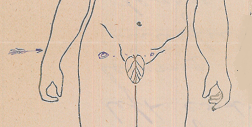
in the right thigh. National Archives
He was with the 85th Pennsylvania at Bermuda Hundred, VA and re-enlisted on June 15, 1864. Two days later, at Weir Bottom Church, on June 17, 1864, during the Battle of the Wilderness, he was wounded behind the right knee, "the ball passing through the back part of the leg." Cousin Sanner carried him on his shoulders for the distance of a mile before arriving at a safe place. Sanner later that day was wounded in the same fight. He was transported to Fortress Monroe, VA, where he was admitted to Chesapeake Hospital for treatment.
Once the second wound healed sufficiently, he received a furlough to return home before receiving orders to rejoin the regiment. After arriving back in the army, he then requested an honorable discharge based on his disability, and following an examination, 85th Pennsylvania surgeon Dr. Samuel L. Kurtz granted the request on Aug. 31, 1864.
|
Norman's home at 1901 Prairie Avenue in Chicago, left, and the Rookery Building which he helped finance and where he maintained his office.
|
 |
Book by Paul Ryscavage |
Upon his return home, Norman filed an application to receive a military pension for his injuries, and it was granted. [Invalid App. #56.946 - Cert. #41.316] He returned to his work at the Harnedsville store. In September 1866, Norman left western Pennsylvania and made a long trip to Princeton, IL. There, he went to work as a general store clerk, and seeing the potential, bought out the owner after just a few weeks.
But 10 months later, the store burned, with him "losing nearly everything," said the History of Chicago. He relocated again to Osceola, Clarke County, IA, about 100 miles southwest of Chicago, and may have encouraged his widowed father and brother Cleon to join him there, as the father sold the family farm and made the voyage in 1868. Other Somerset Countians known to have lived in or near Osceola in the 19th century were Civil War veteran Samuel Freeman Younkin and Moses Younkin of the family of Col. John C. Younkin as well as kinsman John Adam Gaumer of the family of John Gaumer. In Osceola, he worked in the grain and agricultural tool business, but when a season of poor crops in 1870 caused his debtors to default on what they owed him, he was forced to suspend his business.
The following year, the fateful 1871, Norman pushed into the city of Chicago, where he began to make a living as a merchant in livestock and grain in partnership with a Mr. Coffman, dealing in livestock and then into commodities. All might have been lost later that year in Chicago's Great Fire of October 1871, one of America's greatest tragedies up to that time. Reputedly started when a cow of "Mrs. O'Leary" kicked over a lamp in its barn stall, the fire spread all through the city comprising a damaged area of 3.3 square miles, destroying 17,000 buildings and leaving more than 100,000 people homeless. Some 300 were killed over the three-day period. Property damages totaled an estimated $222 million in the dollars of the time, about one-third of the Windy City's overall value.
But Norman saw opportunity in the smoking ruins. He and others were said by news reporters to have formed an "aggressive group of men who supplied the faith and hope which enabled Chicago to emerge triumphant from the fire..."
Circa 1883, he is known to have sold in one day a half million bushels of wheat in Chicago, and due to the economics of the time, the move led to a price drop of three-quarters of a cent, which in essence allowed him to manipulate the market. Around this time, as a wheat and corn trader, he became known as one of the "Big Four" becoming very rich in this work -- Nathaniel S. Jones, John Cudahy and Sidney A. Kent. Norman used his profits from the grain work to invest in the Pullman Company, the large manufacturer of railroad cars.
As well, "He was one of the pioneers in the organization of the steel industry and was active in bringing together the various western steel plants which formed the Federal Steel Company," reported the Connellsville Daily Courier. "When this was absorbed by the United States Steel Corporation in 1901, Mr. Ream became a director of the corporation and has since served as a member of its finance committee, making his offices in this city and his home in Woodstock, Conn. Meantime he had acquired large real estate interests in Chicago and has since maintained an active interest in financial affairs in that city." In November 1884, Norman returned to his home region and stayed in the county seat of Somerset as the guest of A.J. Colborn.
|
Chicago landmarks which Norman helped build through his work. Above: the Armour Meats plant, where he helped founder P.D. Armour corner the market in pork in 1883. Below, the Marshall Field Museum of Natural History. Photo by Mario Scacheri, A. Lenke Studio. |
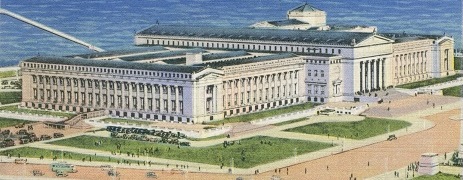 |
At the age of 31, on Feb. 17, 1876, Norman married 23-year-old Caroline "Carrie" Thompson Putnam (1852-1924), daughter of Dr. John and Elizabeth Putnam. The nuptials took place in Madison, NY. They went on to produce nine children -- Marion Buckingham Stephens Vonsiatsky, Frances M. Kemmerer, Bruce P. Ream, Norman Putnam Ream, Robert Clarke Ream, Edward King Ream, Katherine Ream, Louis Marshall Ream and Henry K. Ream. Sadly, three of the children did not survive childhood. Son Bruce, born in September 1879, died at age seven month of acuge pulmonary congestion on April 27, 1880 -- daughter Katherine, born Feb. 1, 1886, succumbed at the age of just five months on July 5, 1886 -- and son Henry K. Ream, born in April 1890, was swept away by scarlet fever at the age of 27 months on July 22, 1892.
In Chicago from 1888 to 1908, the Reams made their home in a three-story brownstone, with 20 rooms, next to and north of the home of department store magnate Marshall Field. Then in about 1908, the family relocated to New York City.
|
Norman B.
Ream with fellow board directors of United States Steel: Richard Lindaburg, Percival Roberts and Elbert H. Gary. Library of Congress |
In addition to U.S. Steel, Norman served on the board of directors of the Baltimore & Ohio Railroad, the Pullman Company, National Biscuit Co. (Nabisco) and the Equitable Life Assurance Society, among many others. At his funeral, President Lincoln's son Robert served as a pallbearer. During his business heyday, Norman frequently rode the B&O Railroad, "often along Laurel Hill Creek through Ursina and past the [Ream] cemetery," said the Somerset (PA) Daily American.
The railroad tracks are located on a hill directly across from the cemetery. Ream decided that when he passed the cemetery, he wanted to be able to see his descendants at rest, so he had all the timber cut away. He then had a retaining wall built at the river bank and a stone wall built to enclose the cemetery.
|
Above, some of Norman's Chicago friends and business associates who were giants of their eras -- L-R: Marshall Field, Cyrus McCormick, Philip D. Armour. Below, other friends, L-R: Robert Todd Lincoln, P.A.B. Widener, Charles Schwab. Library of Congress |
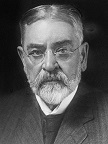 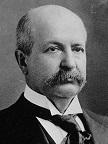 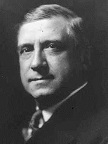 |
Norman was very sentimental about his home village of Ursina. Circa 1888, a story published widely in the Arizona Daily Star in Tucson, Wilmington (NC) Messenger, Topeka (KS) Daily Capital and Abilene (TX) Reporter, among others, Norman said to have been "born in a small log cabin, which is still standing in the village of Ursina, Pa. He occasionally visits it, and it is an object of great interest to him." Then in September 1909, he returned to Connellsville, PA for the 37th annual reunion of his former Civil War regiment and stayed for several days to tour familiar old grounds. Reporters used the opportunity to ask him about the coke and steel business. He responded by saying, "I am fighting over the battles I went through in my youth and for the present coke or steel does not bother me. I came here to attend the reunion and am enjoying it immensely."
After attending services at the Baptist church [in Confluence?], said the Uniontown Morning Herald, he remarked that he wanted to pay for a new building for the church, saying "Go ahead and build the kind of church you want and when the job is done send me the bill." Added the Morning Herald, "Mr. Ream did not hold the congregation down to any particular figures, giving them the liberty of erecting a church every way suitable.... There was great rejoicing among the members and Mr. Ream was made to promise that he would come to Confluence when the structure is ready for dedication." On the same trip, he visited the town of Addison, held a reception in the store of his old friend Mr. Ross, and dined at the Rush Hotel. In 1914, Norman sent a $1,000 check to a relief fund in Ursina when properties were badly damaged in a windstorm.
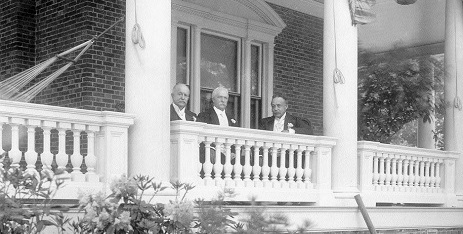 |
| Entertaining guests on the porch in Thompson, allegedly P.A.B. Widener and Marshall Field. Courtesy Thompson Historical Society |
 |
Norman in the last year of his life helped his former Civil War regiment compile a history of their fighting unit. In July 1914, he invited the editorial committee to his home in Thompson, comprised of J.B. Bell of Crafton, PA (Company A), J.A. Swearer and W.C. Craven (Company C), C.E. Eckels (Company E) and C.H. Scott (Company I), with Luther S. Dickey having spent more than a year on the work up to that time. Said the Canonsburg (PA) Daily Notes, "Mr. Ream is financing the workd, and has selected the committee named above to review with him the manuscript to as to determine what shall be published and what shall be eliminated of the vast amount of material collected, in order to reduce the book to such size as will permit its publication at a minimum cost. The work of preparation has been arduous, but every part of it has been carefully performed, and Mr. Dickey has earned the thanks of the surviving members ... for the careful manner in which he has carried it on. He has been materially assisted by diaries kept by various members of the regiment during their service in the war."
In addition to a look back at the War Between the States, Norman also watched the war clouds growing ever darker in Europe in 1914. He told newspaper columnist Dr. E.J. Edwards that he admired how "Germany had gained her enormous overseas trade... Mr. Ream spoke with enthusiasm of the skill, the persistence and the thoroughness with which the Germans had approached the foreign markets and he did not try to suppress his admiratin of the Germans as a trade-triumphing nation, although he frankkly said that some of the interests with which he was associated had suffered somewhat on account of Germany's successful competition in the foreign markets."
During the final year or two, it's said that Norman also became reconciled to his son Louis, having opposed the son's marriage, threatened disinheritance and held out for an annulment.
|
The Reams' mansion in Thompson, CT, known as Carolyn Hall, later the home of Marianapolis College. Below: gardens and lodge on the estate's grounds. |
 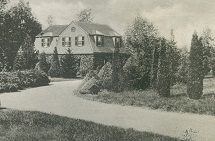 |
Sadly, for his last several years, Norman suffered from intestinal problems that grew worse. He agreed to undergo surgery for appendicitis in New York City's Presbyterian Hospital, but no recovery was to be. He passed away at the age of 70 on Feb. 9, 1915. Later that day, as afternoon newspapers were delivered to hundreds of thousands of mailboxes coast to coast, headlines bore the news of his death.
The obituaries included the oft-repeated statement that "few men in the country kept a closer touch on the business pulse of the United States than he" and that he probably was one of the 25 richest men in the nation. Newspapers estimated his worth between $50 million and $75 million. At the time of Norman's death, his cousin Ross R. Sanner -- who had carried him off the battlefield during the Civil War -- was a school principal in Oakland, MD, completing his 55th year as an educator.
Funeral services were conducted in St. George's Church in Stuyvesant Square. Many friends from Thompson traveled to be there. His remains were placed into repose in Woodlawn Cemetery in the Bronx. [Find-a-Grave]
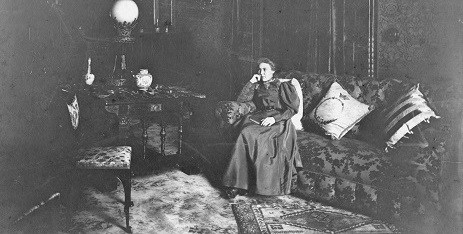 |
| Inside the Ream mansion in Connecticut. Courtesy Thompson Historical Society |
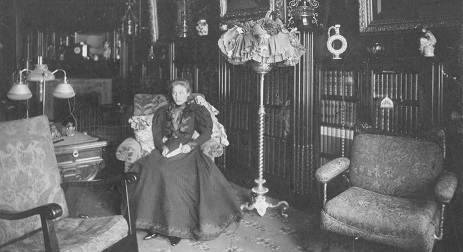 |
Oddly enough, Norman was one of three of the "Big Four" to die within the year. Kent had been gone for a quarter-century. Jones died broke in 1914. The last, Cudahy, passed in April 1915, leaving behind what reporters called a "large estate."
Norman's son Norman and New York Trust Company President Otto T. Bannard were named as co-executors of the estate. When the will was filed in court in Connecticut, officials refused to let it be seen by the New York State Transfer Tax Office, which in turn was seeking the value of stocks and bonds still held by the estate in New York City. New York State's controller Eugene M. Travis ultimately decided that the Empire State had no claim to levy a transfer tax on the assets in question. In the end, the estate paid more than $83,000 in inheritance tax, the largest in the United States that year. The widowed Caroline allegedly received an inheritance of $40 million plus all of their silver and gold ware, household furnishings, pictures, carriages, automobiles, equipment and clothing.
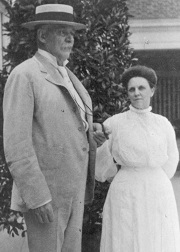 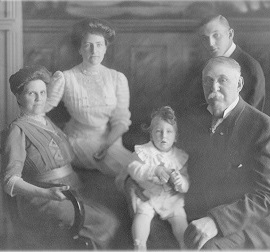 |
| Above: Norman and Caroline and a family portrait, but with whom? Below: an outing in a family automobile. Courtesy Thompson Historical Society |
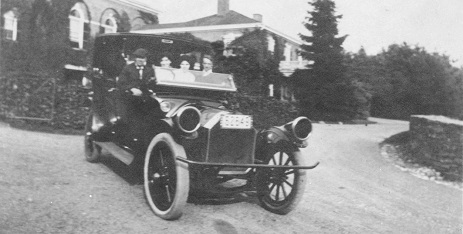 |
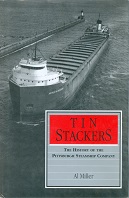 |
Book naming
the SS Ream |
In April 1916, a lengthy profile of Norman was published in the Genealogical and Biographical Record, contributed by Clarence Winthrop Bowen, Ph.D.
For another decade, Marion made her home as a widow in Thompson.
She succumbed at the age of 72, in Pomfret, CT, on Dec. 12, 1924. Interment was with her husband in the Ream family plot in Woodlawn Cemetery in the Bronx.
During Norman's tenure on the U.S. Steel board of directors, the company built a fleet of longer and wider ore-hauling vessels to operate on the Great Lakes. One of them, fabricated by Chicago Ship Building Company, was dedicated in Norman's honor and in his name -- SS Norman B. Ream -- and operated by U.S. Steel's Pittsburgh Steamship Division. The vessel was 587 feet in length with a beam of 58 feet, draft of 28 feet and gross tonnage of 7,053 feet, and its official registry number was US 203543. The Ream was used for decades with its homeport in Duluth, WI and plied its trade in ports in Buffalo, Port Huron, Detroit and Sault St. Marie. After disuse for five years, it was sold in 1965 to Kinsman Transit Company. In the 1960s it operated under the name Kinsman Enterprise and after a subsequent sale to Seaway Terminal Company was renamed Hull No. 1. The vessel was sold for scrap in 1989 in Turkey. The Ream is cited in Al Miller's 1999 book Tin Stackers: The History of the Pittsburgh Steamship Company, published by Wayne State University Press.
|
SS Norman B. Ream and its crew in port
|
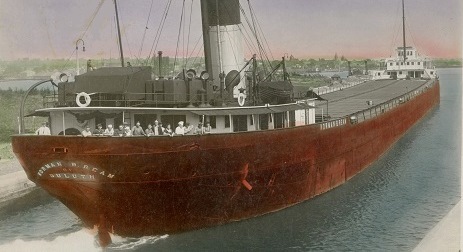 |
~ Daughter Marion Buckingham (Ream) Stephens Vonsiatsky ~
|
| Marion |
She was well-educated, having graduated from Holman-Dickerman School in Chicago and in 1899 from Bryn Mawr College in Philadelphia, with a degree in German and French.
Marion was twice married. Her first spouse was Redmond Davis Stephens (May 30, 1874-1931), son of R.D. and Louisa (Brier) Stephens of Marion, IA. Redmond was a lawyer whom newspapers called "a wealthy Chicago clubman." They were wed on Feb. 18, 1903, when she was 25 years of age and he 28.
The couple dwelled in 1907 at 90 Astor Street and in 1913 at 1365 Astor Street. A graduate of Harvard (1896) and Northwestern University (1899), Redmond practiced law with the firm of Scott, Bancroft, Martin & Stephens, with offices in Chicago. During World War I, he served as a captain in the U.S. Army, and afterward on the War Department Claims Board. At some point he was a board director of the Glenwood Manual Training School.
During yjr first marriage, Marion was active in the community and had an entry in the 1914 edition of Women's Who's Who in America. She served on the Woman's Board of Chicago Hospital, the Home for Destitute Crippled Children in Chicago, the Convalescent Home for Destitute Crippled Children at Prince's Crossing, IL, the Auxiliary Board of children's Memorial Hospital and the Woman's Athletic Club. Also a member of numerous clubs, she belonged to the Service Club, Anti-Cruelty Society, Woman Suffrage League of Illinois, Fortnightly Club of Chicago, Woman's Athletic Club, Bryn Mawr Club of Chicago and Chicago College Club.
 |
Marion and Anastase aboard the President Van Buren, 1934, en route from San Francisco to Manchuria. |
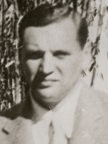 |
Count Vonsiatsky |
But the marriage was troubled, and, reported biographer John J. Stephan, “Quietly but firmly independent, Marion showed little inclination to play demure spouse, fertile mother, and perennial hostess – all expected of a woman of her economic and social station. Marion had her own ideas about how life should be lived.”
Redmond had an affair with a woman named “Priscilla,” and the Stephenses divorced in Chicago in March 1918. In his complaint, said the Hartford Courant, Redmond said that she "wanted to travel all the time; wanted to come and go, she said, as she pleased, and wanted to be free."
Deeply moved by the suffering in Europe during World War I, the divorced Marion went to Paris where she provided relief work services. There, she met 23-year-old Polish immigrant Count Anastase Andreyevitch "V.V." Vonsiatsky (June 12, 1898-1965) who was almost half her age. Born in Warsaw when it was under Russian control, Anastase served in an anti-Bolshevik army of “White” Russians, fighting in eastern Ukraine under the command of Gen. Anton Denikin. He claimed that he and others in his unit had massacred 500 prisoners at Rostov, and that he had been wounded in the abdomen by a gunshot. For the rest of his life, Anastase was devoted to the overthrow of the Soviet Union and its dictator, Josef Stalin.
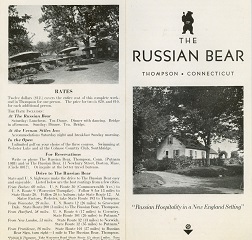 |
Russian Bear brochure |
Marion's first husband went on to serve as a captain in the U.S. Army during World War I. Afterward, he held a seat on the War Department's Claims Board and as assistant budget director in Washington, DC. He married again to Edna Davis ( ? - ? ) of California, with that union ending in March 1929 on grounds of his cruelty. Tragically, Marion he was killed on Feb. 13, 1931 when run over by a moving railroad train in French Lick, IN. The Chicago Tribune reported that the accident was "peculiar" --
In the afternoon he had visited with three friends, among them Henry Hooper of Chicago, and afterwards had gone for a motor ride. The driver left him at the Monon railroad station, a few hundred feet down the slope from the hotel. Mr. Stephens was striding along the platform towards a path leading to the hotel when his foot slipped. Mr. Stephens was somewhat deaf in one ear. He wore bifocal glasses, and dusk was falling. Apparently he neither heard the bell nor saw the headline of the train, which was just starting out of the station. He fell on the tracks and, before the train could be halted, the locomotive struck him.
Marion and Anastase eventually made their home in Thompson and Pomfret, CT. Anastase used Thompson as his home base for years while traveling the world enlisting support for his political cause. In Paris circa 1927-1928, he joined the Brotherhood of Russian Truth and then in 1933, in partnership with Donat Yosifovich Kunle, they formed the All Russian Fascist Organization, or “VFO” for short in Russian. To spread his propaganda, he began publishing the Fashist newspaper, and he set up a local restaurant known as the “19th Hole” as his closet headquarters.
In 1932, when a press photograph showed him playing golf with Prince Theodore Romanoff, son of Grand Duke Alexander of Russia, he was billed as "head of the American Branch of the Fund for the Liberation of Russia." In staged photographs for newspapers, Anastase wore a type of swastika, claiming it was not the German Nazi type but rather pre-Hitler in vintage and white-on-blue in color.
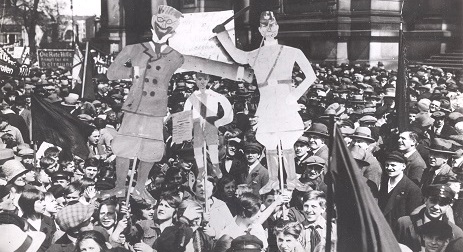 |
| Press photograph, May 1937, with a caption saying that Marion was "devoting her fortune to her husband's ambition to overthrow the Russian Communist Regime." ACME - Pacific & Atlantic Photos Inc. - United Press International |
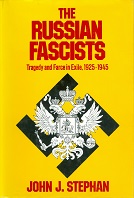 |
Book about the Count's activities |
The U.S. government became suspicious of his activities, and certain informants claimed that Anastase knew and met with Adolf Hitler, Herman Goering and Rudolf Hess during a trip to Berlin. One source, biographer John J. Stephan, states that at least 20 investigations were opened in the 1930s and early ‘40s. Most of these came to the conclusion that he was of no significance and simply “deranged” and a “nuisance.” Stephan reports that friends and enemies alike used words such as “…erratic, outlandish, megalomaniac, and obsessed.” However, a hard-charging prosecutor, Thomas J. Dodd, who later became a U.S. senator, and seemed to relish the opportunity to gain the limelight using as his weapon the Voorhis Act, which required that certain organizations controlled by foreign powers be officially registered with the federal government. Dodd pressed the matter and compiled a persuasive case which led to Anastase’s arrest, conviction and three years and seven months in prison.
Over the years, Anastase’s story was told in other newspapers and books, among them The Russian Fascists: Tragedy and Farce in Exile, 1925-1945 (John J. Stephan, 1978); Protective Shirts (N.N. Grozin, 1939); the newspapers Russky Avangard and The Hour; Sabotage! The Secret War Against America (Albert E. Kahn and Michael Sayers, 1942); The Inside Story of Spies in America (Alan Hynd, 1943); Under Cover (Arthur Derounian, 1943); Presidential Agent (Upton Sinclair, 1944); the autobiography Rasplata (1960); The Battle Against Disloyalty (Nathaniel Weyl, 1951); The Game of the Foxes (Ladislas Farago, 1971); Father Coughlin (Sheldon Marcus, 1973); and Undercover Tales of World War II (William B. Breuer, 2000). Articles were written by such giants as Walter Winchell in Liberty Magazine (Aug. 1, 1942), among others.
Even Marion was dragged into the publicity. Imagine the irony when the Pittsburgh Press, the daily metropolitan newspaper of the home region of her father, printed a photo story headlined “Revolt Against Russia! U.S. Heiress Devotes Fortune to Husband’s Anti-Soviet Party” (May 21, 1937).
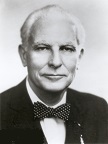 |
Anastase's nemesis Thomas Dodd |
In the 1960s, Marion resided on her Quinnatisset Farm along Route 21 in Thompson.
Sadly, at the age of 87, she died in her winter home in Tucson, AZ on Nov. 11, 1963. An obituary in the Arizona Daily Star in Tucson called her "a patron of the arts" who "long had been active in the support of the Tucson Symphony, the Opera Guild and the Saturday Morning Musical Club. For the last seven or eight years she offered her home at 250 Cottonwood Blvd. for the piano recitals of Robert O'Connor and many other Tucson artists." A public auction of the contents of her Connecticut home was held on April 24-25, 1964, by order of the Chemical Bank of New York Trust Company.
The Count outlived his bride by only two years. He was stricken with a heart attack and died in St. Petersburg, FL on Feb. 7, 1965.
Marion's first husband, Redmond Stephens, remained single for six years and then was wed a second time, on May 20, 1924, to Edna Davis Moore ( ? - ? ). He was named in the Des Moines (IA) Register among the "Notable Sons of Iowa." He spent the final years of his legal career in San Mateo and San Francisco, CA.
|
Above: the Count (right) plays golf in Los Angeles in January 1932 with Prince Theodore Romanoff, son of Grand Duke Alexander of Russia and a cousin of Russia's last czar. Below: the Count (right) entertaining Romanoff at the Russian Bear. |
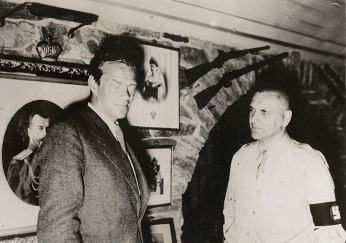 |
~ Daughter Frances Mott (Ream) Kemmerer ~
Daughter Frances Mott Ream (1877-1943) was born on Jan. 15, 1878 in Connecticut.
At the age of 29, on June 9, 1906, she was united in wedlock with John Leisenring Kemmerer ( ? -1944), son of Mahlon S. and Annie (Leisenring) Kemmerer, the father a pioneering coal operator in Wyoming and president and director of Mauch Chunk National Bank in Carbon County, PA. News of the union -- held in the Ream home in Thompson -- was published in the Chicago Inter Ocean and Chicago Tribune. The couple began married life in Scranton, PA.
Their four children were Frances Carolyn Kemmerer, John Leisenring Kemmerer Jr., Mahlon Sistie Kemmerer II and Marion Kemmerer.
Sadness blanketed the family when eldest daughter Frances passed away on Feb. 22, 1909, with burial in Mauch Chunk.
|
Above: Kemmerer, Wyoming, early 1900s. Below: Kemmerer Coal Co. mine #2 in Wyoming, published by City Drug Store. |
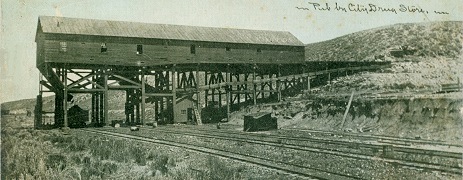 |
John was known as a coal operator in Virginia and Pennsylvania, and by 1935 was chairman of Kemmerer Coal Company of Kemmerer, WY. He also was chairman of the boards of Whitney & Kemmerer, the New York Kemmerer Coal Company and the First National Bank of Kemmerer, the First National Bank of Norton, VA and the Titan Hotel Manufacturing Company of Bellefonte, PA. He also was a director of the American Reinsurance Company, Newmont Mining Corporation and West Virginia Coal and Coke Corporation.
The Kemmerer community, in the southwestern corner of Wyoming along the Cumberland Flats, also is known for its nearby "Fossil Lake" dating to the Early Eocene period of an estimated 52 million years ago. This region, called the "Aquarium in Stone," contains the Fossil Butte National Monument with some of the world's best preserved fossils of birds, fish, insects, mammals, plants and reptiles.
In 1913, the Kemmerers moved to a new home in Short Hills, NJ, where they remained for good. John had a magnificent private library, for which he employed as curator Janet Lewis, whose clients included Elbert Gary of U.S. Steel, Whitelaw Reid and others.
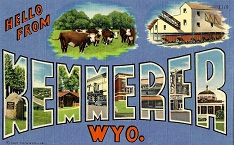
The Kemmerers owned a summer home at Hatchery in Penn Forest, where they regularly vacationed. Circa 1932, they owned a 38-foot cabin cruiser, and avoided a sinking when the cruiser struck wreckage about eight miles offshore of Manasquan.
Frances, who was considered "socially-prominent," died in their home at the age of 66 on April 27, 1943. Reported the Mauch Chunk Times-News, she was "kind and considerate, [and] won the respect and affection of all her associates." Interment was in Short Hills.
John only survived his wife by less than a year. He passed into eternity on March 3, 1944. Word of his demise was sent to his lifelong friend Sally Herpel of Mauch Chunk, whose father had been a coachman for the Kemmerer, Leisenring and Wertz families for 62 years. Said the Times-News, " children's playground, a memorial to the Kemmerer name, now occupies the site of the family's once beautiful home and grounds."
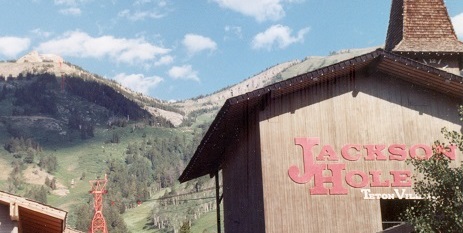 |
| Jackson Hole Mountain Resort, developed in large part by the Kemmerers |
Son John Leisenring Kemmerer Jr. (1911-2002) was born in the summer of 1911 in New York City. He graduated from Princeton University with a degree in geology and the University of Utah with a master's degree. He served as a captain with the U.S. Army in Atlanta during World War II. On Sept. 29, 1939, John married Mary Elizabeth "Mary Liz" Halbach ( ? -2002), daughter of Ernest K. and Elizabeth H. (Stafford) Halbach of Haverford, PA. Their union endured for an extraordinary 63 years. The Kemmerers resided in Short Hills, NJ and produced three children, among them Constance Anne "Connie" Gray, Elizabeth Stafford Brown and John Leisenring Kemmerer III. For some years John served as an inspector for American Re-Insurance Company, "and in that capacity passed on the safety of mines in every producing area in the United States," said the Kingsport (TN) Times-News. In August 1951, at the death of G.C. McCall, he was elected president of the First National Bank of Norton, VA, a position which his father and grandfather had held before him. In reporting on the election, the Times-News said he was "active in civic affairs and a member of the Episcopal Church, [and] has many other interests in Southwest Virginia. He is president of the New York Mining & Manufacturing Co., vice president of the Wise Coal & Coke Co., vice president of the Kemmerer Gen Coal Co. of St. Charles, a director of the Virginia Coal & Iron Co., and also a director of the National Coal Association." He also was president of Kemmerer Coal Company and a director of First National Bank. The Times-News noted that "in immediate Southwest Virginia, his companies have extensive holdings of coal lands in Wise, Dickenson, Lee and Buchanan Counties, in Virginia, and also extensive holdings in Kentucky." John and his adult children are widely known for helping to develop the Rocky Mountain resort town of Jackson Hole, WY, investing more than $230 million in enhancements. Mary Liz was active and influential in her own right, with board of directors roles with the Neighborhood House, Millburn-Short Hills Chapter of the American Red Cross, Millburn Community Council, Short Hills Garden Club and New Jersey Roadside Council. She also gave of her time and resources to the Belize Zoo, Nature Conservancy, Paper Mill Playhouse, Garden Club of America, Christ Church, Overlook Hospital, Junior League of the Oranges and Short Hills, and Girl Scouts of Amerca. The family enjoyed summer holidays on the island of Nantucket. Sadly, Mary Liz and John passed away within less than four months of each other in 2002. She died first, on July 28, 2002, at home in Basking Ridge, NJ. He succumbed at the age of 91 on Nov. 14, 2002 as a patient in Overlook Hospital in Summit, NJ. A memorial service was held at the Liberty Corner (NJ) Presbyterian Church, with the family requesting that any memorial donations be made to the Nature Conservancy of Wyoming. An obituary in the Jackson Hole News and Guide called him:
...a pioneer in the development of Ameerica's western coal reserves and a supporter of many national, state and community organizations.... As chairman and chief executive of the Kemmerer Coal Company, headquartered in New York City, he expanded a family coal mining business to be one of the most successful in the West, with the largest open pit coal mine in the world... Kemmerer established a foundation for the benefit of the town after the family sold its business to Gulf Oil in 1981. In 1992, he created a scholarship endowment so top graduates from the Kemmerer-, Diamondville- and Cokeville-area high schools could attend the University of Wyoming. The unique scholarship covers tuition and all expenses.
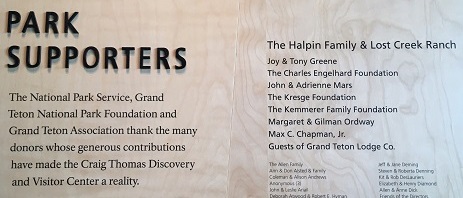 |
| Above: signage naming the family foundation in the Craig Thomas Discovery and Visotor Center, Grand Tetons National Park, and the spectacular mountain range the family is helping the public to more deeply treasure, June 2023 |
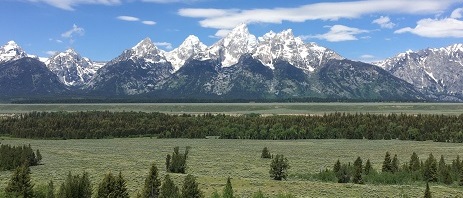 |
- Granddaughter Constance Anne Kemmerer ( ? - ? ) was born on (?). She made her social debut at the Short Hills Club Debutante Ball in 1962 and also at the Mistletoe Ball and International Ball of New York City. Constance was an alumna of the Beard School and Finch College in New York. She is said to have worked in young adulthod with missionaries in Ethiopia. Constance furthered her education with a master of art history degree at Indiana University and circa 1971 was pursuing a master of fine arts degree in anthropology from the University of Denver. On June 10, 1972, she was united in matrimony with James Edward Gray ( ? - ? ), son of Winton Schoonmaker Gray of Sun Valley, ID. The nuptials were led by Rev. George Macray and Rev. Michael Bransfield at Christ Episcopal Church of Short Hills, NJ and announced in the New York Daily News and Chicago Tribune At the time of their marriage, James was studying at Denver and teaching at St. Anna's School. She eventually took back her maiden name. Circa 2003, she helped create the Integrative Healthcare Foundation, later renamed Teton Wellness Institute. In this role, she and a woman with multiple sclerosis together climed Mount Kilimanjaro in Tanzania.
- Granddaughter Elizabeth Stafford "Betty" Kemmerer ( ? - ? ) was born on (?). As a young woman, she was presented socially at the Short Hills Club in 1962 and the Mistletoe Ball in New York. She received her education at the Oldfields School in Glencoe, MD, Bennett College in Millbrook, NY and the University of Colorado. On April 12, 1972, in nuptials held in Libby, MT, she entered into marriage with Frederick Walker Brown ( ? - ? ), the stepson of Harry U. Perry of Oscoda, MI. Frederick was a graduate of Alpena (MI) Community College.
- Grandson John Leisenring "Jay" Kemmerer III (1947-living) was born in 1947. He was a gradaute of Salisbury (CT) School and Clarkson College of Technology in Potsdam, NY. He obtained his bachelor of arts degree in finance from the University of Denver. Circa 1972, Jay was employed with National Newark & Essex Bank. On Nov. 25, 1972, he wed Suzanne Marie Kumler ( ? - ? ), daughter of William Lawrence Kumler of Pacific Palisades and Palm Springs, CA. Rev. Norman Y. Ishizaki presided at the ceremony, held at St. Alban's Episcopal Church in Los Angeles. She was a graduate of Palisades High School and the Ecole Montesano of Gstaad, Switzerland. She pursued additional education at the University of Arizona and the University of Lausanne, Switzerland, majoring in French. One known daughter of the family was Noel Morgan Kemmerer. Jay was employed for three years with the Chemical Bank in New York in the 1970s before joining the Kemmerer Corporation. He was closely involved with the family's acquisition of the Jackson Hole Mountain Resort in Wyoming and the CM Rancy of Dubois, WY, as well as the Seven-Up Bottling Company. Jay held a seat from 1988 to 1992 on the board of the National Soft Drink Association. In 2007, he is known to have served as trustee of the Kemmerer Family Foundation which made a $1 million donation to the township library in Harding near Morristown, NJ. He also founded the Harding Land Trust. Jay married a second time, in 2009, to Karen Varnas ( ? - ? ), with the nuptials taking place in Jackson Hole.
Son Mahlon Sistie Kemmerer II (1913-1963) was born in February 1913. He received a bachelor's degree in geology from Princeton University in 1934, and while there was captain of the varsity polo club. He then enrolled at the University of Utah in September 1934, to pursue a mster's degree in mining engineering, and he flew there in his red Waco monoplane. On one outing with a young lady in October 1934, his aircraft burst into flames, and he somehow force-landed the plan in Wendover, UT. He became a geologist and in 1935 was employed at Grass Valley, CA. On Sept. 12, 1936, Mahlon was united in holy wedlock with Collette "Noel" Fitch ( ? - ? ), daughter of Cecil A. and Collette Noel (Cunningham) Fitch of Eureka, UT, who was president of Chief Consolidated Mining Company, which operated silver-lead mines in and around the town of Tintic. The Kemmerers' ceremony was held at St. Patrick's Catholic Church, officiated by Rev. Elliot Reardon. Noel was an alumna of Menlo Park College and attended the San Francisco College for Women. Six children produced in this marriage were John Kemmerer, Peter Kemmerer, Martha Fitch Hanifin, Frances Kemmerer, Colette Jacquet and Victoria Rebecca "Becky" Ausserlechner. During World War II, Mahlon served as a flyer with American Export Line. Over the years, he became nationally recognized as a mining engineer and was employed with Newmont Mining Company in New York, O'Kiep Copper Company in Africa and then finally with the mining and business finance firm Whitney and Kemmerer, Inc., where he held the title of vice president. He was credited with helping to develop the Ambrosia Lake uranium mining operation near Grants, NM, and the company Sabre-Pinon Corporation, which became United Nuclear Corporation. The Kemmerers resided in Larchmont, NY at 90 Park Avenue. Sadly, at the age of 50, Mahlon suffered a cerebral hemorrhage at home and died in a New Rochelle hospital on Nov. 16, 1963. Obituaries were printed in Albuquerque, Salt Lake City, Boise, New York and Philadelphia. Noel outlived her spouse by 16 years. She passed away in about Nov. 1979. Her obituary in the New York Times reported that her funeral mass was held in St. Dominic's Church in Larchmont, with interment following in Gate of Heaven Cemetery. Her headcount of survivors included a dozen grandchildren.
- Grandson John C. Kemmerer (1939- ? ) was born in about 1939 in Utah. He was an alumnus of Portsmouth Priority in Providence, RI and studied economics at Georgetown University in the District of Columbia. He made a home in Princeton, NJ in 1979.
- Grandson Peter Kemmerer (1943- ? ) was born in about 1943 in New york. He dwelled in New York City in 1979.
- Granddaughter Martha Fitch Kemmerer (1940- ? ) was born in about 1940 in Utah. She was a graduate of Elizabeth Seton High School in Yonkers, NY and an alumna of Katharine Gibbs School of New York while also studying at Marymount Junior College in Arlington, VA. On April 30, 1960, in St. Augustine's Church in Mamaroneck, she entered into marriage with John William Hanifin ( ? - ? ), son of John W. Hanifin of Hastings-on-Hudson. News of the wedding was printed in the Mamaroneck Daily Times. At the time, John was pursuing his doctorate in chemistry from Rutgers University, having graduated from Hastings High School and the College of the Holy Cross in Massachusetts. The pair made a home in 1962 in Highland Park, NJ and in 1979 in Sufferin, NY.
- Granddaughter Frances Kemmerer (1942- ? ) was born in about 1942 in Utah. She was a 1959 graduate of the Convent of the Sacred Heart in Greenwich, CT and then with friends took a month's tour of Hawaii . She made a residence in 1979 in Chicago.
- Granddaughter Colette Kemmerer (1945- ? ) was born in about 1945 in New York. She was a 1963 graduate of the School of the Holy Child. She was joined in wedlock with Jean-Pierre Jacquet ( ? - ? ). The couple dwelled in Paris, France in 1979.
- Granddaughter Victoria Rebecca Kemmerer (1948- ? ) was born in about 1948 in New York. After high school graduation, Victoria attended the Barbizon school of modeling. On June 9, 1979, she wed Austrian immigrant Karl/Carl Ausserlechner ( ? - ? ) in a ceremony held in Bedford, NY. He was trained as a pastry chef and cook and had worked as assistant chef at the Greenwich Country Club and Pelham Country Club. Having been together for 10 years prior to marriage, including period of time in Austria and California, they moved to Connecticut in 1982. One daughter of this union was Noel K. Ausserlechner. Karl went on to food service employment at Sarah Lawrence College, the A.S. Department Store in Paramus NJ and then opened the Kaffee Bazar in Armonk, NY, which was in operation until he sold it in 1986. The couple divorced in January 1994 in Connecticut Superior Court.
Daughter Marion Kemmerer (1914-1957) was born on Sept. 6, 1914 in New York City and spent virtually of her life in Short Hills, NJ. She took many trips to Europe as a young lady, including sailing to Sweden (in 1934) and England (1935 and 1936). She is known to have attended the Westover School in Simsbury, CT and Baldwin School in Bryn Mawr, PA. At the age of 25, in 1940, she resided with her parents. On Aug. 13, 1942, when she was 27 years of age, Marion married Alexander Earle "Alec" Green/Greene (Aug. 17, 1910-1970). Their wedding was held in the District of Columbia. Alec had been self-employed in 1940, making a home in DuBois, PA. A trio of offspring born to the couple were Christopher Earle Greene, Jonathan Laird Greene and Alexandra Greene. In 1943, the newlyweds' residence was in Denver, with their children all born in different states between 1943 and 1947. By 1950, the pair had separated, with Marion and the children dwelling in Larchmont, NY, while Alec made a home in Southern California and married again to Betty ( ? - ? ). Her accress in 1957 was on Joanna Way, Short Hills. Marion was stricken by a heart attack and passed away on Dec. 10, 1957, at the age of 43. An obituary was printed in the Item of Millburn and Short Hills. Interment of the remains was in St. Stephen's Episcopal Cemetery in Millburn, NJ following a funeral service conducted in Christ Church. Alec outlived his former wife by a baker's dozen years. He died in Los Angeles on Feb. 3, 1970. His funeral ws held in Old North Church, and the remains were buried in Forest Lawn Memorial Park in Hollywood Hills. A brief death notice was published in the Los Angeles Times.
- Grandson Christopher Earle "Kit" Greene (1943-1994) was born on July 21, 1943 in Pennsylvania or New Jersey. He wed Geraldine G. ( ? - ? ), and the couple divorced in Washoe, NV on May 17, 1982. His residences over the years were Los Angeles and Reno. He passed away in Los Angeles on Oct. 19, 1994.
- Grandson Jonathan Laird Greene (1945- ? ) was born in about 1945 in Colorado.
- Granddaughter Alexandra "Sammy" Greene (1946-2012) was born on Aug. 19, 1946 in New York City. She was given the nickname by her older brothers from the television cartoon character "Yosemite Sam." She was 11 years old when her mother died, and she went to live with her father in Southern California. On April 9, 1994, at the age of 47, Alexandra entered into marriage with Jim Ogren ( ? - ? ), son of Eric Carl Gustave and Zina (Snyder) Ogren. The couple did not reproduce. They owned a 22-acre estate in Mapleton, UT with acres of gardens and buildings full of antiques that were featured in the Hidden Garden Tour. Alexandra was considered vivacious and had a passion for adventure. She raised horses and attend many horse shows, with a love for arena horse jumping, barrel racing and mixed roping. She tried her hand at working at a furniture store, jewelry store, cafe and pharmaceutical business. She enjoyed singing and organ-playing. On Sept,. 11, 1997, the couple was featured and pictured in a Provo Daily Herald article headlined "Antiques Capture Earlier Era." On the tragic evening of May 20, 2012, she lost her life in an accident when another vehicle driven by a teen fleeing from police collided with her vehicle. The wreck occurred on University Avenue in Souith Provo near the interchange with Interstate 15. James was injured and taken to Utah Valley Regional Medical Center but fortunately survived. A funeral service was held at White Church in Mapleton, UT, with burial in Springville Evergreen Cemetery. A related story appeared in the Deseret News.
~ Son Norman Putnam Ream Sr. ~
 |
Norman Putnam Ream Thompson Historical Society |
He graduated from Michigan Military Academy in 1902 and then went on to study at Packard's Business College in New York. By 1905, he was employed Trust Company of New York. Circa 1915, he is believed to have enlisted in the U.S. Army, serving with the Squadron A Cavalry in New York City. He lived in Chicago in 1916 and in New York City in 1918-1924.
The Chicago Tribune announced in March 1916 that Norman had been engaged to Mary Green (July 9, 1881-1975), daughter of Adolphus W. Green, of Greenwich, CT and New York City, who was president of National Biscuit Company (Nabisco) which Norman's father had helped to create. The wedding was held at the Plaza Hotel in New York City, with Rev. Fr. Fitzgerald, of the St. Vincent Ferrer Church, officiating. The New York Sun reported that "The bride, who walked to the temporary altar with her father, wore a costume of white satin and net made with a long court train. She wore also a veil of tulle and carried a bouquet of lilies of the valley and white orchids. Robert C. Ream was his brother's best man." The couple honeymooned in California and Japan.
At least two children born to this union were Norman Putnam "Put" Ream Jr. and Caroline Lincoln.
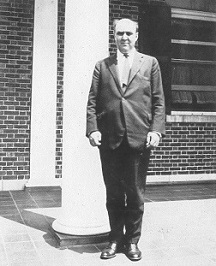 |
Norman at Carolyn Hall Thompson Historical Society |
Circa 1940, Norman resided on Porchuck Road in Greenwich, CT and paid a visit to his aged uncle and aunt, Cleon and Isabelle Ream, in Illinois, as noted in the Bloomington (IL) Pantagraph.
At the death of his sister Marion in November 1963, Norman was named in newspaper obituaries and at the time was residing in Tucson.
Norman died in Greenwich on June 12, 1964. His remains were interred in the Ream family plot in Woodlawn Cemetery in the Bronx, New York. [Find-a-Grave]
Mary survived for another 11 years and maintained a home in Tucson.
She succumbed to the angel of death on March 7, 1975.
Son Norman Putnam "Put" Ream Jr. (1918-2001) was born on Nov. 23, 1918 in New York City. In April 1943, the Nashville (TN) Banner and Huntsville (AL) Times reported that he was engaged to Phoebe Page Shofner ( ? - ? ), daughter of Eugene Forrest Shofner. The wedding was held on May 1, 1943, in the Hotel Plaza in New York City, by the hand of Rev. Fr. Fitzgerald. Their union endured for a remarkable 58 years. The couple's brood of offspring included Norman Ream, Christopher Ream and Margaret Ream. During World War II, he served in the U.S. Navy. Norman enjoyed the world of boating and water during his long lifetime and is known to have participated in the Trans-Pac and Newport to Ensenada races over the years as well as Pacific Ocean cruises near San Diego and the Coronado Islands. He passed away in Rancho Santa Fe, CA at the age of 82 on March 22, 2001. His cremains were scattered followed by a wake in the Ream home. In an Oceanside (CA) North County Times obituary, the family asked that any memorial donations be made to the American Lung Association.
- Grandson Norman Ream lived in Encinitas, CA in 2001.
- Grandson Christopher Ream dwelled in 2001 in Pacific Beach.
- Granddaughter Margaret Ream made her residence in 2001 in Encinitas, CA.
Daughter Caroline T. Ream ( ? - ? ) was born on (?). She was a graduate of Rosemary Hall of Greenwich, CT and then for two years attended a school in Paris. She was joined in marriage with Thomas R. Lincoln ( ? - ? ), son of Leroy A. Lincoln of New York. Thomas was an alumnus of Princeton University and at the time of marriage was enrolled in the New York Law School. He was a member of the Princeton Club of New York. In 1968, the Lincolns lived in Greenwich, CT. They were the parents of Letitia Putnam Lincoln, Carolyn Ream Demas, Cynthia W. Lincoln and Mary Louise Lincoln. As of 2001, Caroline was in Greenwich.
- Granddaughter Letitia Putnam Lincoln ( ? - ? ) was born on (?). She attended Briarcliff College in New York and the University of Lausanne in Switzerland. Circa 1968, she was a junior studying at the University of Arizona. She entered into marriage with James Douglas Kitchel ( ? - ? ), son of Denison Kitchel. Their one known daughter was Cynthia Wheeler Kitchel. The couple divorced, and she married again to (?) Pratt ( ? - ? ), while James wed Faye.
- Granddaughter Carolyn Ream Lincoln ( ? - ? ) was born on (?). She was an alumna of the Westover School and Finch College. On Dec. 17, 1966, in nuptials held at the Greek Orthodox Church of the Archangels, she wed John George Demas ( ? - ? ), son of George N. Demas of Sparta, Greece. The marriage was announced in the Port Chester (NY) Daily Item, which said that the bride "wore the satin and lace wedding gown of her maternal grandmother, Mrs. Norman Putnam Ream of Greenwich. Her tulle veil with a beaded crown also belonged to Mrs. Ream." John was a graduate of the U.S. Naval Academy and a four-year veteran of the Navy and, at the time of marriage, was studying at the Harvard Graduate School of Business Administration.
- Granddaughter Cynthia W. Lincoln ( ? - ? ) was born on (?).
- Granddaughter Mary Louise Lincoln ( ? - ? ) was born on (?).
~ Son Robert Clarke Ream ~
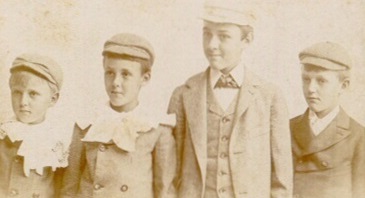 |
| Robert, 2nd from left, with brothers, L-R: Louis, Norman, Edward Smith & Warren Studio, Putnam, CT. Courtesy Thompson Historical Society |
Son Robert Clarke Ream (1882-1957) was born on Aug. 31, 1882 in Chicago.
He was a 1904 graduate of Princeton University.
On Oct. 24, 1907, when he was 25 years of age, he married Priscilla "Mabel" Wrightson ( ? - ? ) of England, daughter of a Presbyterian clergyman. The news of their union, held at the English country estate of her family, at Ockenden Hall, Cuckfield, Sussex, was printed in newspapers in his hometown of Chicago. Robert's sister and brother in law, Marion and Redmond Stephens, traveled to England to attend the nuptials.
The Reams produced three known sons, Robert Bruce Ream, Henry Putnam Ream and John Wrightson Ream.
Robert made his home in 1918-1924 in New York City and served as personal secretary and assistant to his father.
Heartbreak blanketed the family on March 13, 1922 when 13-year-old son Robert, a student in Pomfret School in Connecticut, caught a deadly case of pneumonia and succumbed in Putnam Hospital. News of the untimely passing was published in the Norwich Bulletin and Vogue magazine. In his memory, a stained glass window was dedicated in the Pomfret School chapel.
|
Pomfret Chapel with a window dedicated in Robert Jr.'s memory
|
Among others, Robert served on the board of directors of the Carolina, Clinchfield and Ohio Railway, a line which ran through the Blue Ridge Mountains to points south, and the Texas and Pacific Coal and Oil Company. He also founded an insurance firm, Ream, Wrightson & Company, was president of the American Re-Insurance Company, organized in 1917, and in 1930 he was elected to the board of the Seaboard Air Line Railway.
Circa 1920, Mabel served as a director of the New York Exchange for Women's Work, and in 1961 was pictured in the Hartford Courant as president of the national organization.
They dwelled at Wallack Point in Stamford, Fairfield County, CT in 1935. When the 1940 federal census was enumerated, the Reams lived in New York City and employed a waitress, cook, kitchen maid and chamber maid in their home.
Robert is believed to have died on June 2, 1957.
Son Henry Putnam Ream (1914-1962) was born on Oct. 16, 1914 in Manhattan. He received a degree from Princeton University in 1937. A classmate recalled that he "was quiet and unassuming and well liked by all those who knew him." At the age of 25, in 1940, he lived at home with his parents in New York City and earned a living as a clerk in his father's insurance business. At the age of about 28, in 1942, he was united in wedlock with Sybil Atwood Watson (1920?-2010), daugher of Thomas Perry and Meta (Atwood) Watson. They were the parents of four offspring, Robert Bruce Ream, John Atwood Ream, Priscilla Parker and Henry Putnam "Hank" Ream Jr. He seems to have left behind the trappings of big business. Henry and Sybil made their residence on Sea Island, GA, where he purchased and operated a shrimp boat. Sybil spent her life in McIntosh and Glynn Counties, GA and attended a business school in Savannah. She was a member of St. Andrews Episcopal Church in Darien and Christ Church of St. Simons Island. Sadly, Henry passed away at the age of 47, on April 6, 1962, in Sea Island, Glynn County, GA. Interment was in Atwood Family Cemetery in Valona, McIntosh County, GA. In an obituary, the Princeton Alumni Weekly reported that "Unfortunately not many of us in the Class were in touch with Henry so not a great deal is known about his more recent activities... the Class first lost touch with him when he dropped back into the Class of 1938. For a few years he was carried on their olls. He then elected to return to the Class with which he entered college, and attended our 20th Reunion." Sybil married again to Albert Brewer Baker Jr. (1915-1982). He brought these children to the union -- Albert Brewer Baker III and Steve Baker. Said a newspaper, she "was a lover of the McIntosh marshes and the North Carolina mountains, nothing was more important to her than her family and friends. She was a constant source of love and encouragement. Her love of life and the joys life provided her has served as an inspiration to all who knew her." Eventually she outlived both of her husbands as well as two grandsons. At the age of 90, Sybil passed away at the Brunswick Hospital of Southeast Georgia Health Systems on June 24, 2010. Her remains were placed into eternal repose in the family cemetery with Rev. Ted Clarkson leading the funeral services. The family requested that any memorial contributions be made to St. Andrews Episcopal Church or the Hospice of the Golden Isles.
-
Grandson Robert Bruce Ream ( ? - ? ) was born in (?). He was united in matrimony with Patricia ( ? - ? ). They produced at least one son, Robert Bruce Ream Jr. Sadness enveloped the family at the death of their son Robert Jr. on Feb. 13, 1974. Circa 2010, the Reams resided in Pointe Vedro Beach, FL.
-
Grandson John Atwood "Johnny" Ream resided at Pointe Vedra Beach, FL and in 2010 in Sea Island.
-
Granddaughter Priscilla Ream ( ? - ? ) was born in (?). She wedded Jimmy Parker ( ? - ? ) and made their residence on St. Simons Island. They had one known son, James Andrew Parker. Son James wedded Annie Jane Wood, as reported in the Greenville Tribune-Times.
-
Grandson Henry Putnam "Hank" Ream Jr. ( ? - ? ) was born in (?). He received a bachelor's degree from the University of Georgia. On Jan. 3, 1981, he married Elizabeth King ( ? - ? ), daughter of Robert R. and Daughtry (Hardin) King. News of their engagement was printed in the Atlanta Constitution, and the nuptials were held in St. Simons Presbyterian Church. Their known children were Henry Putnam Ream III, Jennifer Ream and William Ream. They made their home for many years on St. Simons Island, GA. Their son Henry III was a student at Glynn Academy, where he played varsity tennis. Tragically, on March 14, 2002, at the age of 18, he was killed when riding in his father's Volvo, driven by a friend, which "veered off the roadway, hit a ditch and overturned several times before striking a tree," reported the Florida Times Union. Interment was in Oglethorpe Memorial Gardens in Georgia.
Son John Wrightson Ream (1919-1985) was born on Sept. 26, 1919. On March 26, 1949, in a ceremony held in Greenwich, CT, he married Barbara Borden (1918-1997), a native of Greenwich, CT. News of their nuptials was published, among other journals, in the Princeton Alumni Weekly. Their three known children were Peter W. Ream, Robert Clarke Ream II and Glentworth Borden Ream. John served as vice president of American Reinsurance Company in New York. Barbara was a graduate of Rosemary Hall School in Greenwich and later of Low Haywood School and the Parsons School of Design. They resided in Greenwich and had a summer home in Hyannisport, Cape Cod, MA, and moved for good to the Cape in about 1950. During World War II, she volunteered with the American Red Cross and the VNA on the Cape. Reported the Cape Cod Times, she "was a member of the Wianno Club, the Hyannisport Club, the West Beach Club, the Beach Club of Centerville, the Beach Club of Palm Beach, Fla., the Palm Beach Yacht Club, the Royal Poinciana Club, the Indian Harbor Yacht Club of Greenwich, Conn., Hortilus and the Garden Club of America." Sadly, John passed away in Hyannisport at the age of 65 on Jan. 21, 1985. An obituary was published in the Boston Globe, which said that his funeral was held in St. Mary's Church in Barnstable. Barbara passed away in August 1997. Memorial services were held in St. Andrews by the Sea Episcopal Church in Hyannisport. In an obituary printed in the Cape Cod Times, the family asked that any memorial donations be made to Cape Cod Hospital Foundation, American Heart Association or American Society for the Prevention of Cruelty to Animals.
-
Grandson Robert Clarke "Robby" Ream II ( ? -2016) was born in (?). As a young man, Robert graduated in 1969 from Trinity-Pawling School and studied at the University of New Hampshire. Following graduation, he spent two years working for Grenfell Mission in Cartwright, Labrador. On June 17, 1978, he was united in marriage with Deborah Lee Syrek ( ? - ? ), daughter of Walter J. Syrek of Depew, NY. News of their engagement was published in the New York Times. At the time of marriage, Robert was employed in sales at the Puritan Department Store in Hyannis, while Deborah, a graduate of the University of Massachusetts, worked as a registered medical technologist at Strong Memorial Hospital in Rochester, NY. They produced two children -- Courtney Ream and Garrett Ream. The Reams made their home in Yarmouthport on Cape Cod. Sadly, Robert died on July 9, 2016. A notice of his passing was printed in his alumni magazine, the Trinity-Pawling Magazine.
-
Grandson Glentworth Borden Ream (1952-2014) was born in about 1952. He grew up in Greenwich and spent summers on Cape Code, where he sailed with the Hyannis Yacht Club and Wianno Club, skippered the family-owned Wianno Senior, raced in the Edgartown Regatta and founded the Hyannis Angler's Club. He graduated from Brunswich Boys School and attended Eaglebrook School and Tabor Academy before graduation in 1975 from Babson College with studies at Boston University. He never married. In his early career, Glentworth was employed with Connecticut General Life Insurance Company. After leaving Connecticut General, he and his brother Robert founded their own business, Robert and Glen Ream Antiques. He resided in 1997 in Hyannis, where he was founder and proprietor of the Black Cat Restaurant. Said the Cape Cod Times, in this role, "his artistic qualities prospered with the decor and notable cat portraits found throughout the restaurant." In more recent years he made his home in Lauderdale-by-the Sea near Fort Lauderdale. Sadly, he passed away at the age of 62 on March 3, 2014. His obituary was printed in the Times.
-
Grandson Peter W. Ream (1954-living) was born in 1954 in Greenwich, CT. He wedded Patricia "Patty" Rogers (1955-living), a native of Portland, ME. They initially dwelled in Wenham, MA and then made their home in Manchester by the Sea for many years. Their offspring -- all born in Boston -- are Constance Ream (born 1987) and twins Hollister Wrightson Ream and John Wrightson Ream II (1990).
~ Son Capt. Edward King Ream ~
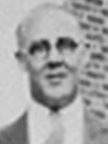
Thompson Historical Society
Son Edward King Ream (1884-1946) was born on Sept. 28, 1884 in Chicago.
At the age of six, in October 1890, with help from the groom's young sister Florence, he served as a bridal attendant and scatterer of roses in the wedding of Albertina Huck and Marshall Field Jr., the only son of the great Chicago merchandising giant Marshall Field.
Edward grew to manhood in his parents' Chicago residence, a three-story brownstone, with 20 rooms, next to and north of their neighbor Field. He is shown in the 1900 federal census enumeration at the age of 15, and was listed as "at school."
He graduated from Princeton University in 1905 and devoted the early years of his career to the work of coal merchant and mining superintendent. He carried the sobriquet "Captain" but how that was earned is not yet known.
On July 27, 1909, in Jeffersonville, KY, he was joined in matrimony with 30-year-old Ellen Morton "Nellie" (Speed) Armstrong (June 24, 1879-1957), with magistrate James S. Kelgwin officiating. At the time of marriage, she was employed as a registered nurse and resided in Dorchester, VA. The couple asked the circuit clerk to keep the marriage a secret, and the news did not become public until December 1909.
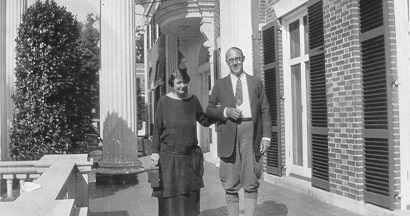 |
| Edward and (presumably) his wife Nell, circa 1916 Courtesy Thompson Historical Society |
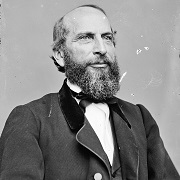 |
Nell's ancestor James Speed, Lincoln's Attorney General Library of Congress |
Nellie was the daughter of coal merchant James Speed Jr and the granddaughter of President Lincoln's attorney general James Speed Sr. Divorced from her first husband (?) Armstrong, she thus brought two stepdaughters into the union with Edward -- Hattie Speed (Armstrong) Nickell and Frazier Morton (Armstrong Ream) Wanless Hill.
The Reams became the parents of two children of their own -- Bell Quigley Kitchen and Bethel Veech Ream. One of the daughters were married to H.D. Mitchell.
As newlyweds, Edward and Nellie relocated to his father's home region of Somerset County, PA. There, in 1910, they dwelled in a hotel in Hooversville, operated by Gustavus and Sophia Wasseen, and he was employed as a coal mine superintendent. Nellie's daughters Hattie and Frazier dwelled with them at that time.
Circa 1916, the Reams lived in nearby Johnstown, Cambria County, PA.
By 1924, they relocated to Kentucky, with a residence in Buechel, KY, and Edward was named that year in the obituary of his mother. When the federal census enumeration was made in 1920, the family lived in Hoke, Jefferson County, KY, with Edward marked as a dairy farmer.
They moved to Versailles, Woodford County, KY in about 1930 and lived at 168 High Street. Circa 1932, their home was in The Commodore hotel in Louisville. They are known to have enjoyed spending their summers at a camp along the Kentucky River.
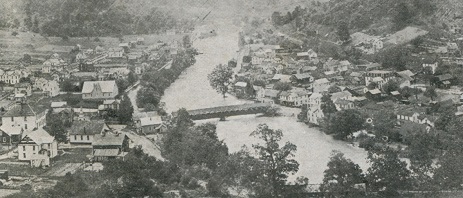 |
| Above: Hooversville, PA, the Reams' home in 1910. Below: Louisville, KY, where they resided in the 1930s. |
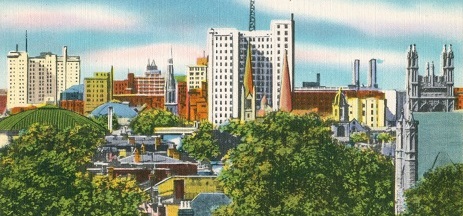 |
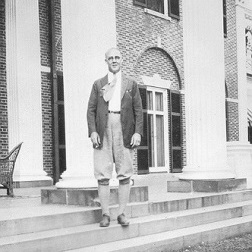 |
Edward at his parents' home Thompson Historical Society |
Edward and Nellie lived on High Street in Lexington in 1943. They moved to a new home circa 1946 -- in a hotel in Frankfort, KY -- "due to the housing shortage in Versailles," reported the Cincinnati Enquirer.
On Sept. 30, 1946, he suffered a fatal heart attack at the hotel. A funeral mass was held at the Good Shepherd Catholic Church in Frankfort, with burial in Cave Hill Cemetery in Louisville, Jefferson County. [Find-a-Grave]
Nell outlived her husband by 11 years and made a home on Stout Avenue. She died in Versailles on Aug. 8, 1957, with burial beside her husband. The Lexington Herald carried an obituary.
Daughter Hattie Speed Armstrong (1900- ? ) was born in about 1900 in Kentucky. On Jan. 3, 1922, at the age of 21, she entered into marriage with Harry Brock Nickell ( ? -1969). The wedding took place at the First Christian Church, by the hand of Rev. Dr. E.L. Powell. News of the union was proclaimed in the Louisville Courier-Journal. They went on to bear a duo of daughters including Nell Best and Jane Speed McDonnell. The family initially was in St. Louis and then spent many years in Indianapolis. Their address in 1934 was 533 East 56th Street and at 5681 Guilford Avenue in 1945. Harry rose to become vice president of the forest products firm Pierson-Hollowell Company over a 30-year career. He is known to have served as treasurer of the American Walnut Manufacturrs Association circa 1944. In retirement, they lived in Boca Raton, FL. Harry died at the age of 75 in May 1969, with an obituary printed in the Indianapolis News.
- Granddaughter Nell Nickell (1923-2011) was born on April 8, 1923 in St. Louis, MO and came to Indianapolis as a newborn of three months of age. She was a student at Butler University in Indianapolis in 1944. On June 4, 1944, in the university's Sweeney Chapel in Indianapolis, she wed Jack Walter Best ( ? -2009), son of Harry W. Best of Cumberland. They remained together for an extraordinary 65 years. Together, the Bests bore four children -- Nancy N. Best, Judy Phillips, Sally Coffman and Thomas Best. Jack seerved in the U.S. Army during World War II. After his tour of duty ended, he returned to Indiana. They dwelled in Muncie, IN in 1945 and the next year moved to Richmond, IN, where they remained just under two decades. Jack spent his early career working for the U.S. Treasury Department and Palladium (IN) Item daily newspaper. Nell was profiled in a May 7, 1961 article in the Richmond Palladium-Item about her famous ancestor, James Speed. A Kentucky native, Speed was President Abraham Lincoln's Cabinety member and attorney general and worked on behalf of anti-slavery measures. The article went into details about Speed's relationship with Lincoln, using as source material a book of Nell's, James Speed, A Personality, published in 1914. The family relocated to Arlington, TX in 1964, where Jack was employed as controller for A.H. Belo Company, owner of the Dallas Morning News as well as newspapers in Garland, Grand Prairie and Richardson. The family joined the First United Methodist Church of Arlington, TX, where both were active with its Aldersgate Sunday School class, she taught its preschool students and he was a member of the congregation's board. She also was a volunteer at Arlington Community Hospital, later renamed MCA Hospital. She lived by the creed "laugh more and worry less." Jack's favorite saying was ""God granted me a wonderful life with my dear wife Nell and family. What more could a man ask for?" Said the Fort Worth Star-Telegram, Jack "was active in the International Newspaper Controller and Finance Officers and served as president from 1963 to 1964. He was an emeritus life associate of the Institute of Management Accountants. Jack had been a Kiwanian since 1956 [and] served in several leadership positions over the years, including president, treasurer and lieutenant governor of Division 39 of the Texas-Oklahoma district." Nell and her sister Jane were named in the Lexington (KY) Herald-Leader obituary of their aunt Bell Kitchen in 2000. Grief enveloped the family when, at the age of 89, Jack died in Arlington on Dec. 14, 2009. As of 2014, Nell dwelled in Arlington, TX. Her final residence was at Green Oaks Nursing Home. Sadly, at the age of 87, she was spirited away by the angels on March 7, 2011. Her funeral service was held at the First United Methodist Church in Arlington, followed by burial in Moore Memorial Gardens. An obituary appeared in the Fort Worth Star-Telegram.
Great-granddaughter Nancy N. Best ( ? - ? ) was in Florida in 2011.
Great-granddaughter Judy Best married Daniel Phillips. As of 2011, the pair dwelled in Tennessee.
Great-granddaughter Sally Best wed James Coffman. They established a residence in Arlington, TX.
Great-grandson Thomas Best ( ? - ? ) was deceased by 2011.
- Granddaughter Jane Speed Nickell (1930-2014) was born on the next-to-last day of 1930 in Louisville, KY. Her girlhood was spent in Indianapolis and was a student at 84 School and Shortridge High School. She then received her undergraduate degree from Purdue University. On July 26, 1952, she married Miles C. McDonnell ( ? - ? ), son of Thomas Edward McDonnell of Birmingham, MI. The wedding was held in St. Paul's Episcopal Church and announced in the Indianapolis News. Five offspring born to this marriage were Peggy M. McDaniel, Miles C. McDonnell Jr., Patrick E. McDonnell, Michael N. McDonnell and Timothy B. McDonnell. Reported the Orlando (FL) Sentinel, "An active volunteer, Jane enjoyed membership in the Kappa Alpha Theta Sorority Alumni Group, and the Winter Park and Orange County Medical Auxiliaries. She was a charter member, past president (1965-1966), and active sustainer of the Junior Service League of Orlando/Winter Park, and past treasurer of the Orlando Museum of Art's Council of 101 where she was dedicated to the annual Antiques Show and Sale." Her second husband was widower Dr. John Corbett Blalock Jr. ( ? -2021). He had been married previously to Shatteen Taylor, MD (Feb. 23, 1934-1967) and brought three stepsons into the union -- Ryan Blalock, John Corbett Blalock III and Alan Taylor Blalock. Their final home together was in Maitland, FL. Jane surrendered to the angel of death on Aug. 23, 2014. Her memorial service was held at All Saints Episcopal Church in Winter Park. In a Sentinel obituary, the family requested that any memorial donations be made to the Fanconi Anemia Research Fund or the Alzheimer's Association. John survived his bride by seven years. Death claimed his life on Jan. 14, 2021. An obituary in the Sentinel called him "a pillar of the 'Last Great Generation' and said that he was "Respected by all, beloved by friends and family, he fulfilled his every ambition, both personal and professional, with integrity, tenacity, and love. His legacy is eternally inspirational for all to pursue personal excellence." This time, the family asked that any contributions in his memory be made to Emory University Medical School or the Florida Conservation Coalition.
Great-granddaughter Peggy M. McDaniel was in Winter Springs, FL in 2014.
Great-grandson Miles C. McDonnell Jr. has resided in Winter Park, FL.
Great-grandson Patrick E. McDonnell dwelled in 2014 in Winter Springs, FL.
Great-grandson Michael N. McDonnell wed Tanya. Their home in 2014 was in Winter Springs, FL.
Great-grandson Timothy B. McDonnell married Jill. They have lived in Maitland, FL.
Step-great-grandson Ryan Blalock made his residence in Maitland, FL in 2014.
Step-great-grandson John C. Blalock III had an address of Port Charlotte, FL in the mid-2010s.
Step-great-grandson Alan Taylor Blalock put down roots in Maitland, FL.
Daughter Frazier Morton Armstrong Ream (1902-1945) was born on Oct. 8, 1902 in Louisville, KY. She was age seven when her mother married Edward King Ream, and the girl is believed to have taken the "Ream" surname. Frazier was active socially in her teens, and her name frequently was included in Owensboro, KY newspaper stories about social gatherings and visits. On Nov. 12, 1920, at the age of about 18, she was to have entered into marriage with George Smith Wanless (1898-1961), son of Joseph Wanless, and it was to have been "one of the social events of the season," reported the Owensboro Messenger. But they decided a month early to change plans and get married right away, and their ceremony was held on Oct. 17, 1920, in Jeffersonville, KY, by the hand of a civil magistrate. Said the Messenger, "The bride left a $3,000 trousseau untouched." Frazier's parents objected to the union and tried to have it annulled. At the time, George earned a living with Robinson Bros. & Co. The couple held firm and in August 1921 vacationed with her parents and siblings at a camp along the Kentucky River. Using the name "Mrs. George Wanless," Frazier was matron of honor at her sister's wedding in December 1921. Then in October 1927, together with Frazier's mother, they sailed to Italy for a holiday of several weeks' duration. But the match ultimately was troubled, and in April 1929, making her home in the Commodore Apartments on Everett Avenue, she sued for divorce. She alleged in her complaint that her husband "sneered at her religion and did not want her to go to church." Later in 1929, Frazier retook her "Ream" surname and, in company with her half-sister Belle, spent the summer in Montreal before sailing together with their parents to Europe in October. Then on July 11, 1931, she wed again to Dr. David C. Hill ( ? - ? ) in Louisville. Their union was announced in the Louisville Courier-Journal. Their only son was David Morton Hill. The Hills established a home in Woodford County, KY. Sadly, Frazier contracted a serious illness and suffered for several years. She succumbed to the spectre of death at the age of 40 in a hospital in Louisville on March 30, 1945. Officiating at her funeral was Rev. Fr. G.H. Lynes of St. Louis Bertrands Church, with interment following in Cave Hill Cemetery, Louisville.
Grandson David Morton Hill (1933-2013) was born in 1933 in Paris, KY. At the age of 12, he was a student at Millersburg Military Institute in Kentucky in 1945 and an alumnus of St. Johns Military Academy in Delafield, WI. During the Korean War, he served in the U.S. Army and received a Purple Heart. Reported the Quincy (MA) Patriot Ledger, "After leaving the service he went to Hollywood, CA to pursue an acting career. He appeared in Johnny Guitar, The Rose Tattoo and The Eternal Sea. He was nominated for an Oscar for Best Supporting Actor in the film The Rose Tattoo." These film credits are not yet confirmed, and David's name does not appear in their respective entries in the Internet Movie Database (IMDb.com). David was united in matrimony with Wilma Farell ( ? - ? ). Two children in this family were David E.L. Hill and Michael W.L. Hill. Eventually they migrated to Massachusetts and resided in Norwood and Braintree, MA. From 1975 to 1995, a span of two decades, David was employed in inventory control at the Stop & Shop Warehouse and held a membership in the Teamsters Union. David died at the age of 79 on May 21, 2013. His funeral mass was held in St. Francis ofAssisi Church, Braintree, with interment in Braintree Cemetery. An obituary in the Boston Globe said he was survived by a sister, Dinah "Kay" Winters.
Purple Heart Great-grandson David E.L. Hill married Diane and in 2013 made a home in West Bridgewater, MA.
Great-grandson Michael W.L. Hill wed Kristy. They have lived in Bridgewater, MA.
Daughter Bell Quigley Ream (1915-2000) was born in about 1915 in Pennsylvania. She grew up in Louisville, KY and, in July 1929, traveled with her half-sister Frazier to Montreal to spend the summer before sailing to Europe in October. She attended St. Mary's Academy in Illinois in 1932. On June 12, 1937, in Versailles, KY, Bell wed Wilbur "Edgar" Kitchen ( ? - ? ). Rev. Robert Gregory Lyons traveled from St. Louis to officiate the happy event, held in the parish house of St. Leo's Catholic Church. News of the wedding was published in the Cincinnati Enquirer. At the time, Wilber was employed in the Kentucky State Revenue Department. They became the parents of four girls -- Frances "Fan" Dishman Shelburne, Marie Carolyn Kitchen, Susan K. Martin and Lou Nunnelley. Bell held a membership in St. Leo Catholic Church as well as the Woodford Hospital Auxiliary, Garden Club and Midway Women's Club. Circa 1935, she was accepted in the Daughters of the American Revolution, General Marquis Calmes Chapter, and maintained this connection for the remaining 65 years of her life. Similarly active in the Woodford County Womans Club, she rose to influence as treasurer and president and then became its sixth district governor. In January 1943, her attempt to revoke the trust funds established by her parents for her benefit was unsuccessful in the case Kitchen vs. New York Trust Co. The trustees of the trusts were New York Trust Bell's uncles Norman P. Ream and Robert C. Ream. In 1956, at the acquisition of the Women's Civic Center of Woodford County, a historic house at 247 Lexington Street in Versailles, she became its curator and served in this role permanently. The Civic Center also undertook philanthropic and educational projects and activities benefitting the residents of the county. Deeply interested in thoroughbred horse breeding, racing and sales for more than six decades, she belonged to the Keeneland Club and Kentucky Thoroughbred Owners and Breeders Association. Said the Lexington Herald-Leader, "The Kitchen family has bred several stakes winning thoroughbreds including Eclipse Award older mare Track Robbery. Sadly, Bell passed away in the Markey Cancer Center in Lexington at the age of 85 on Oct. 14, 2000. She was pictured in her obituary in the Herald-Leader. Jointly conducting her funeral mass at the family church were Rev. Fr. Frank Osburg, Rev.Fr. Raymond Stratman and Rev. Fr. Charles MacDonald. Her remains were interred in Versailles Cemetery, with William McGeorge Dishman III, J.J. Martin, Ben Martin, Dr. Ivan Shelburne, Mike Martin and Denny Nunnelley serving as pallbearers. The family made a request that any memorial donations be made to McDowell Cancer Foundation or the Women's Civic Center.
- Granddaughter Frances R. "Fan" Kitchen attended Centre College and married William McGeorge Dishman Jr. ( ? - ? ), son of William McGeorge Dishman Sr. of Danville, KY, a student at the University of Kentucky School of Law. One known son born to the pair was William McGeorge Dishman III. Later, she wed Ivan Shelburne ( ? - ? ). Their home in 2000 was in Danville, KY.
- Granddaughter Marie Carolyn Kitchen dwelled in Versailles, KY in 2000.
- Granddaughter Susan Kitchen was joined in matrimony with Michael "Mike" Martin. They are believed to be the parents of J.J. Martin and Benjamin Martin. The couple put down roots in Versailles, KY.
- Granddaughter Lou Kitchen was united in wedlock with Denny Nunnelley. Their two known daughters were Kayla Ream Nunnelley and Beth Nunnelley.
Son Bethel Veech Ream (1918-1968) was born in February 1918. He was a graduate of the University of Kentucky and studied at the Columbia University School of Journalism. During World War II, he served in California with the U.S. Naval Reserve. In about 1948, Bethel was wed to Nancy Sherwood Seaton (Nov. 25, 1923-2010), daughter of Kendall Gordon and Grace Mary (Watson) Seaton of Ashland, KY. Nancy was a graduate of Laurel School in Shaker Heights, OH and Smith College in Northampton, MA. As a young adult, she spent about 18 months working for the Army Intelligence Service in Washington, DC before taking a new position in the office of the president of the University of Chicago. The pair went on to produce two sons -- Edward Kendall Ream and David Speed Ream. Circa 1947, reported the Woodford (KY) Sun, Bethel visited his sister Belle while traveling from Chicago to Mexico City. He is known to have dwelled in Evanston, IL in 1948. Bethel entered into marriage a second time with Gladys M. ( ? - ? ). Together circa 1960 they owned the Casas Adobes Book Store in a shopping center on North Oracle Road near Tucson. Glady sued for divorce in Tucson in 1964. Bethel's third wife appears to have been Rita M.K. ( ? - ? ). Alleging a host of grievances, she sued for divorce in Chicago in 1966. Circa 1966, Bethel's home was in Chicago. Bethel died unexpectedly in Jacksonville, FL at the age of 50 on March 1, 1968. Burial was in Cave Hill Cemetery, Louisville. His obituary appeared in the Lexington Herald. Nancy married again to John Harry Dornbos ( ? - ? ). Four offspring from the second marriage were Jill Dornbos, Jay Dornbos, David Dornbos and Jeff Dornbos. They made a home in Indian Harbour Beach in Brevard County, FL. Nancy volunteered her time with Daily Bread in Melbourne, FL and the South Guild of the Brevard Symphony Orchestra where she served as president and received a volunteer of the year award. Reported Florida Today, she was "a member of the local Embroiderers Guild and a founding member of the Space Coast Smith Club. A lifelong Episcopalian, she sang for many years in the St. Sebastian-By-The-Sea Church Choir, in Melbourne Beach, FL. She and her late husband, John, enjoyed traveling throughout the United States in their motor home 'Humble', and sea cruises in more recent years." The couple belonged to the Eau Gallie Yacht Club, and in her free time Nancy liked to craft needle point, read and play Scrabble and bridge. Nancy passed away at the age of 86 on June 4, 2010. Her memorial service was conducted in the family church. Today, an endowment she created with the Community Foundation for Brevard continues to support her favorite causes.
- Grandson Edward Kendall Ream ( ? - ? ) lived in Wilmette, IL in 1968. He entered into marriage with Becky ( ? - ? ). As of 2010, he was in Madison, WI. Edward is project leader and chief programmer of a software program known as Leo, said to accelerate the workflow of programmers, authors and web designers.
- Grandson David "Speed" Ream ( ? - ? ) resided in 1968 in Wilmette, IL. He made his home in 2010 in Melbourne, FL and has been involved with his mother's endowment fund with the Community Foundation for Brevard.
~ Son Louis Marshall Ream Sr. ~
|
Book about the doomed |
Son Louis Marshall Ream Sr. (1887-1970) was born on July 7, 1887 in Chicago.
He graduated from Princeton University in 1908 and then went to work as an assistant secretary for the New York Trust Company. In April 1910, he became engaged to Mary Gilliat Naylor ( ? - ? ), daughter of Mrs. George Naylor, as announced in the Chicago Tribune, but there is no evidence that the couple actually wed.
In 1911, Louis met a beautiful stage actress, 23-year-old Eleanor P. Davidson ( ? - ? ), while at the Chateau des Beau Arts in Huntington, Long Island. Using the stage name "Eleanor Pendleton," she was known for performances with Elsie Janis in The Slim Princess and also appeared in The Hoyden, The Fair Co-ed and The Bachelor Belles. They married in early September 1911, but his father did not approve of the match, and threatened to dis-inherit the son.
|
Eleanor Pendleton Sarony/Tremont Theatre |
Reported the New York Times, Louis and his father are "said to have become reconciled ... before his death" in 1915. In 1916, Louis' home was in Worcester, NY.
Former wife Eleanor went on to marry film actor (?) Lawler. In 2014, the story of Eleanor's effort to receive a financial settlement, "that triggered sensational headlines and a high-stakes courtroom battle," was told in H. Thomas Howell's book Eleanor's Pursuit (Archway Publishing).
At theage of 31, on June 1, 1918, he entered into marriage with his second bride, Mary S. Weaver ( ? - ? ), daughter of Charles S. Weaver of Putnam Heights and Thompson, CT. The nuptials were held in the Congregational Church in Thompson, performed by Rev. William B. Chase and Rev. Theodore Manning Hodgdon. At the time, he served as an aviator in the U.S. Navy. After a honeymoon, the Reams made their home in Chevy Chase, MD at 5 West Melrose Street.
The couple produced two children -- Mary Louise Crossgrove and Louis Marshall Ream Jr.
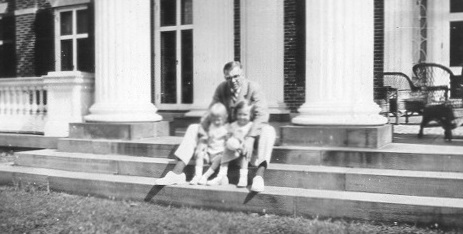 |
| Louis and unidentified youngsters, possibly his children? Thompson Historical Society |
The marriage was troubled, and Mary allegedly shot Louis in the shoulder at a July 1924 dinner party. The couple separated soonafter. That winter, Mary took her mother and the children to live in Atlantic City. Claiming that Louis "displayed a violent and ungovernable temper," said the Hartford Courant, Mary filed for divorce, and it was granted in 1925 in Superior Court in Hartford. On Dec. 23, 1926, she married a second time to New York City banker Newell P. Weed ( ? - ? ). They lived in Thompson but did not reproduce. The Weeds divorced on June 13, 1932, with Mary claiming "intolerable cruelty." On Jan. 11, 1933, she married again to Russian immigrant Alexis Kraplish, an airplane designer living in New York who had connections to Sikorsky Aviation Corporation of Stratford, with the news reported in the Hartford Courant.
Louis eventually became a vice president for American Steel and Wire Company in Rhode Island.
 |
Louis and his new automobile Thompson Historical Society |
Marion is believed to have brought two children to the marriage, Eleanor Ahbe and Janet T. Drayton. As a young woman, she was a musical performer and remained interested in promoting the musical arts for the rest of her life.
The 1940 U.S. census shows the family in Providence, with Louis' occupation shown as "secretary - college board." Their address at that time was 6 Olive Street. Marion served as a Red Cross Motor Corps volunteer during World War II.
During World War II, in 1942, Louis appears to have commissioned research of the Ream family and its origins in Germany. The resulting 26-page typed document, entitled "The Ream Family," traces the clan back to one "Nicholeus Rym" of the town of Leimen in 1432. The typescript today is preserved in the Rhode Island Historical Society but sheds no light onto the Minerd family connection with the Reams.
Louis spent his final years in Delray Beach, FL. As his health failed, he was admitted to a local nursing home, where he died on Oct. 28, 1970. An obituary in the Palm Beach Post reported that memorial services would be held in Providence's Swan Point Chapel.
As a widow, Marion lived in Abbey Delray in Delray Beach, FL. She died at the age of 90 on Dec. 8, 1984. An obituary appeared in the Palm Beach Post naming her husband, children and stepchildren. She was survived by 13 grandchildren and a dozen great-grandchildren.
Daughter Mary Louise "Marylou" Ream (1919-1985) was born on March 16, 1919 in the District of Columbia. She married Robert R. Crossgrove ( ? - ? ). Robert appears to have brought a stepdaughter into the union, Margot Fell. The couple went on to produce five offspring of their own -- Katherine Crossgrove, Margaret Crossgrove, Molly Ouelette, James Crossgrove and Robert Crossgrove. In 1970, they dwelled in Arlington, VA and in 1984-1985 in Wolftown, Madison County, VA. For many years, she was employed as a hospital administrator. Mary Louise also was a shareholder of her brother's Zaca Mesa Ranch and Winery. Sadly, at the age of 66, Mary passed away on Nov. 15, 1985 in the University of Virginia Hospital in Charlottesville. Funeral obsequies were led by Rev. Tom Maddrey in the Rose Park United Methodist Church. In her obituary in the Culpeper Star-Exponent, the family requested that any memorial contributions be made to the Madison County Rescue Squad.
- Step-granddaughter Margot Crossgrove wed (?) Fell. Her residence in 1985 was in Donmills, Ontario, Canada.
- Granddaughter Katherine/Kathryn Crossgrove established a home in Brandy Station, VA.
- Granddaughter Margaret Crossgrove was a 1967 graduate of Walnut Hill School in Natick, MA. In a related article in the Virginia Chronicle, she disclosed plans to further her education at Ithaca College. Eventually she settled in Arlington, VA.
- Granddaughter Molly Crossgrove was joined in wedlock with (?) Ouelette. She relocated to Andover, MA and was there in the mid-1980s.
- Grandson James Crossgrove put down roots in Wolftown, VA.
- Grandson Robert Crossgrove lived in Oakton, VA in 1985.
Son Louis Marshall "Marsh" Ream Jr. (1921-1994) was born on Aug. 26, 1921 in Thompson, CT. He married Manhattan native Cornelia Louise "Connie" Porter (Jan. 19, 1928-2010), daughter of Hugh C. and Louise Porter, the father a New York architect. The couple produced five offspring -- John Marshall Ream, Mark Thomas Ream, Bruce Clinton Ream, Scott Weaver Ream and Carolyn Priscilla McPheeters. During World War II, Louis served in the U.S. Army's chemical division in Hawaii. He received a chemical engineering degree at Princeton University and a master's of business administration from the Wharton School of Business at the University of Pennsylvania. He accepted employment with Atlantic Refining Company and rose to the position of executive vice president for research and development, overseeing the company's merger with Richfield to becoming ARCO. "During the early years of the merger," said the Hackettstown (NJ) Star-Gazette, "oil was discovered at Prudoe Bay, Alaska by the ARCO crew. When the company moved to California, Mr. Ream and his family purchased a ranch and this later became a vineyard, known as the Zaca Mesa Ranch and Winery. Mr. Ream was the chief executive officer and president of this business until his retirement in the late 1980s." In August 1971, Cornelia christened the SS Arco Prudhoe Bay, a 70,000-ton tanker, at its fabrication site at the Sparrows Point yard of Bethlehem Steel. They were members of the St. James Episcopal Church of Hackettstown, NJ, St. Philip in the Fields in Oreland, PA and St. Marks in the Valley in Los Olivos, CA. Circa 1979, he served on the board of trustees of the Dunn School. He died in Glenlora Nursing Home in Chester, NJ on Jan. 10, 1994 at the age of 73. Funeral sevices were private, with obituaries appearing in the Los Angeles Times and the Star-Gazette, noting that survivors included nine grandchildren. The family asked that any memorial donations be made to the Northern New Jersey Chapter of the Alzheimer's Association. Cornelia lived for another 16 years, with her final home in Columbia, Richland County, SC. She succumbed there at the age of 82 on Aug. 28, 2010.
-
Grandson John Marshall Ream (1948-2001) was born on Aug. 21, 1948 in Philadelphia. He married (?) Chin ( ? - ? ), daughter of Leonard Chin of Jamaica. The couple bore one known daughter, Teja Lin Ream. He resided in Buellton, Santa Barbara County, CA circa 1994-2001. Sadly, at the age of 52, John died in Buellton on Aug. 5, 2001. His remains were placed into rest in Oak Hill Cemetery in Ballard, Santa Barbara County. Inscribed on his grave marker are the words "Always In Our Hearts" in addition to what appears to be Asian script.
-
Grandson Mark Thomas Ream ( ? - ? ) was born in Philadelphia, where he grew to manhood. He studied the classics for two years at Kenyon College in Gambier, OH. That was followed by a relocation with his family to Los Olivos in the Santa Ynez Valley of California. Circa January 1978, he married Margaret Mary "Maggie" Spalenka ( ? - ? ), formerly of Carlsbad, CA. They were the parents of Christopher Thomas Ream. The Reams lived at Zaca Mesa Ranch in Los Olivos, CA in 1982, where he worked for a decade. The family made a home for years in Buellton, CA. Mark joined the Santa Barbara County Sheriff's Department as a dispatcher in 1985 and was promoted to deputy at the Solvang Substation in 1988. In the early 1990s, he gave of his time teaching the Santa Ynez Valley Union High School student assistant team on how to deal with students in crisis. He was pictured with his horse Pokey in a May 14, 1982 article in the Santa Ynez Valley News, which said he was "a law enforcement officer who enjoys his work and believes volunteering is one way to make a lasting impact in the community.
-
Grandson Bruce Clinton Ream ( ? - ? ) was born in Philadelphia. As a youth, he graduated from the Darrow School in New Lebanon, NY and attended Ohio University in Athens, OH. Circa 1971, he was employed by A.C. Croft Educational Services in New London, CT. On June 19, 1971, he was united in matrimony with Suzanne Moore Pennink ( ? - ? ), daughter of Karel B. and (?) (Barclay) Pennink, the father a senior executive with General Motors Overseas Operations. Their engagement was announced in the New York Times, with the nuptials held in St. John's Episcopal Church of Cold Spring Harbor on Long Island. At the time of marriage, Suzanne was an alumna of Emma Willard School of Troy, NY and the College Marie José of Antwerp, Belgium and a student at Connecticut College. Over the years, Bruce dwelled in West Canaan, CT and in 1994 in Cranston, RI. He appears to be interested in the Ream genealogy, and if so, we ask that he contact us privately.
-
Grandson Scott Weaver Ream was born in Philadelphia. He lived in 1994 in Newton, NJ.
-
Granddaughter Carolyn Priscilla Ream was born in Philadelphia. As a young woman, she graduated from Dunn School and attended Sweet Briar College for Women in Sweet Briar, VA. She divided her time between family homes in Los Olivos, CA and Wickford, RI. On June 12, 1981, in nuptials held in Wickford, she married Kenneth K. McPheeters ( ? - ? ), son of Kenneth K. McPheeters of Lake Forest, IL. At the time of marriage, he was in his senior year at Washington and Lee University in Lexington, VA. News of the wedding was printed in the Santa Ynez Valley News of Solvang, CA. In 1994, her residence was in Beaufort, SC.
Stepdaughter Eleanor Thresher (1915-1985) was born in 1915 in Providence. At the age of 19, she graduated from Baldwin School at Bryn Mawr near Philadelphia and in 1938 from Wellesley College. She married John Leavitt "Jack" Ahbe ( ? -1993), a native of Athens, PA. The children born to this couple were John Leavitt Ahbe Jr., Marion Lord and Eleanor Anne Thomas. John was an alumnus of the Shattuck Military School in Minnesota and Lafayette College. He served in the U.S. Army Intelligence's Army Trading Command during World War II. He earned a living over the years in the field of wealth management. His first position was with Keystone Company in Boston, and in 1947 relocated to Palm Beach to open his own firm, John L. Ahbe & Company. From 1956 to 1968, said the Palm Beach Post, his work took him to New York, New Jersey, back to New York and finally to West Palm. In the community, John served as president of the American Red Cross chapter in Palm Beach County and of the Old Guard of Palm Beach. He also was president of the Theta Delta Chi alumni of Lafayette College and belonged to the New York Bankers Association, Rotary Club of Palm Beach, New York Numismatic Society, New York Downtown Athletic Club and the Sailfish Club of the Palm Beaches. In 1950-1952, Eleanor served as president of the Palm Beach Junior Welfare League and in 1971-1972 as chair of the Sustainers of the Junior League. Said the Palm Beach Daily News, "Her interests included coin collecting. She specialized in British coinage and its history. She was a member of the American Numismatic Club and the royal Numismatic Society of Great Britain." Their address in the 1970s was 2600 North Flagler Drive in West Palm. Sadly, Eleanor passed away on July 14, 1985, with an obituary published in the Daily News. After Eleanor's death, John married a second time to Arleen Seeley ( ? - ? ). She had been wed before and brought three children to the second union, Teina S. DeBakey, Beverleigh S. Bertland and Herbert B. Seeley III. John died in West Palm Beach at the age of 84 on Oct. 16, 1993. Memorial services were conducted in the Bethesda-by-the-Sea Church, with an obituary appearing in the Palm Beach Post.
-
Step-grandson John Leavitt Ahbe Jr. made his home in Miami in 1993.
-
Step-granddaughter Marion A. Ahbe wedded (?) Lord. She dwelled in Tavares, FL in 1985 and in Jacksonville, FL in 1993.
-
Step-granddaughter Eleanor "Anne" Ahbe was born in (?). In about 1973, she married William Neil Thomas III ( ? - ? ), son of William Neil Thomas Jr. of Lookout Mountain, TN. In 1985-1993, she resided in Lookout Mountain.
Stepdaughter Janet Thresher (1919- ? ) was born in about 1919 in Rhode Island. At the age of 21, unmarried, she lived at home with her mother and stepfather. She wedded (?) Drayton. Her home in 1984-1985 was in New York City.
|
Copyright © 2002, 2009, 2012, 2014-2017, 2019, 2025 Mark A. Miner |
|
Civil War sketch of Norman Bruce Ream from the History of the Eighty-Fifth Regiment, Pennsylvania Volunteer Infantry by Luther S. Dickey (New York: J.C. & W.E. Powers, 1915). Later N.B. Ream sketch from the History of Bedford, Somerset and Fulton Counties. |
